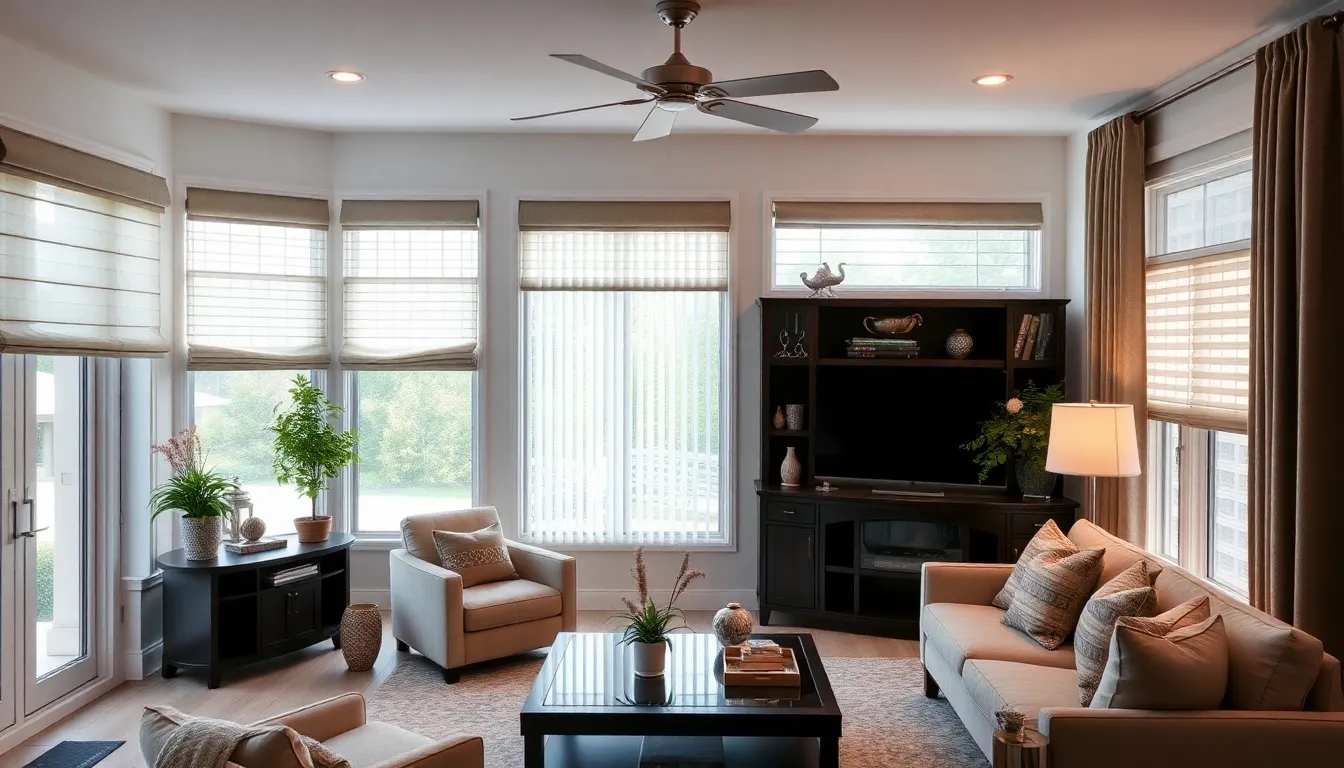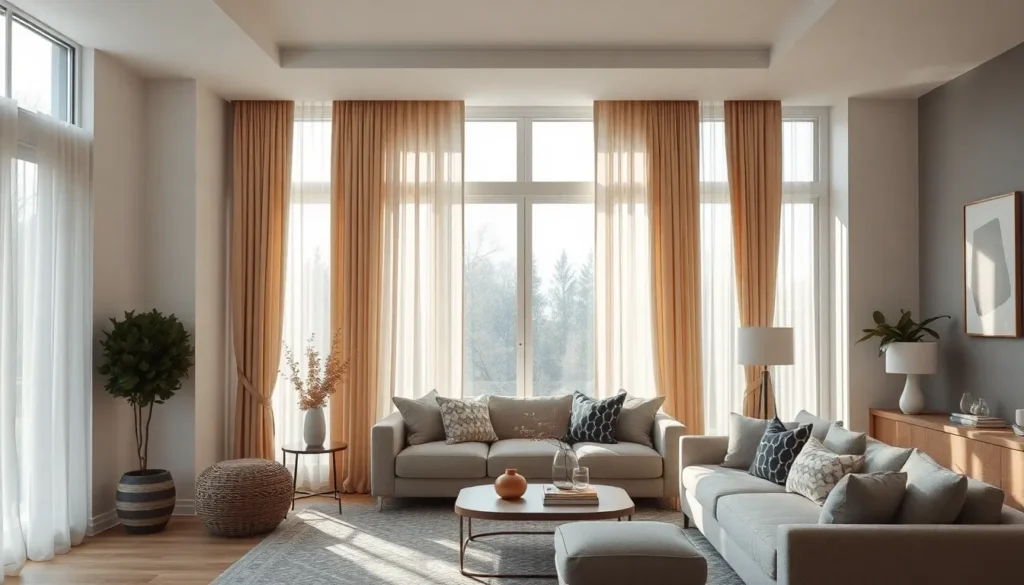When it comes to home decor, blinds and curtains play a crucial role in enhancing both functionality and aesthetics. These window treatments not only provide privacy and light control but also serve as stylish elements that can transform any room. Choosing the right option can elevate the atmosphere of a space while reflecting personal style.
With a myriad of styles, materials, and colors available, it’s easy to feel overwhelmed. Whether opting for sleek, modern blinds or elegant, flowing curtains, understanding the unique benefits of each can simplify the decision-making process. This guide will explore the key differences, advantages, and tips for selecting the perfect window treatments to suit any home.
Table of Contents
ToggleOverview of Blinds and Curtains
Blinds and curtains serve essential functions in home décor. They provide privacy, control light, and enhance the aesthetic of spaces. Blinds, often made from materials like aluminum, wood, or vinyl, feature slats that can adjust to control light penetration. Curtains, typically fabric panels, offer a softer look and come in various lengths, colors, and patterns.
Differences Between Blinds and Curtains
- Material: Blinds use hard materials, while curtains use soft textiles.
- Light Control: Blinds allow for precise light adjustment; curtains generally offer less control.
- Aesthetic Appeal: Blinds create a modern vibe; curtains add warmth and texture.
Advantages of Blinds
- Versatility: Blinds suit different styles, from contemporary to classic.
- Maintenance: Blinds require minimal upkeep compared to curtains.
- Durability: Blinds, especially those made of synthetic materials, resist wear and tear.
Advantages of Curtains
- Insulation: Curtains enhance thermal efficiency, helping to regulate indoor temperatures.
- Sound Absorption: Thick curtains can dampen noise, providing a quieter environment.
- Customization: Curtains offer extensive customization options in colors and designs, meeting diverse preferences.
Selecting the right window treatment hinges on personal style, functionality, and maintenance preferences. Understanding the unique traits of blinds and curtains aids in making informed choices.
Types of Blinds and Curtains

Window treatments come in various types, each offering unique features and benefits. Understanding these options helps in selecting the perfect fit for any home.
Roller Blinds
Roller blinds consist of a single piece of fabric that rolls up and down using a spring or chain mechanism. They provide a sleek, modern appearance and come in numerous colors, patterns, and opacity levels. Popular materials for roller blinds include polyester and cotton, which allow for both light filtering and blackout options. Easy to clean and maintain, roller blinds suit a range of interior styles from minimalistic to contemporary.
Roman Blinds
Roman blinds feature fabric that folds into pleats when raised, creating an elegant, tailored look. Available in various fabrics, including cotton, linen, and synthetic blends, they can complement diverse decor styles. Roman blinds can be customized for length and height, ensuring a perfect fit for any window. Their aesthetic appeal also comes with light control options, providing a balance of privacy and brightness in the room.
Vertical Blinds
Vertical blinds consist of long fabric panels that hang vertically from a track. These blinds are highly functional, allowing for adjustable light control and privacy by tilting or drawing the panels aside. Commonly used in larger windows and sliding glass doors, vertical blinds are made from materials like vinyl, fabric, and aluminum. They’re easy to clean and can be found in numerous colors and styles, making them a versatile choice for both residential and commercial spaces.
Custom Curtains
Custom curtains offer a range of styles, fabrics, and hardware, providing flexibility for personalized decor. Homeowners can select from various lengths, widths, and header styles, ensuring that the curtains match the specific dimensions and aesthetics of their windows. Fabrics range from sheer to heavy drapes, allowing for light filtering, insulation, and sound absorption. Custom options ensure a unique look that reflects the homeowner’s taste while enhancing the overall ambiance of the room.
Benefits of Using Blinds and Curtains
Blinds and curtains offer numerous advantages that enhance both functionality and decor in any space. They provide practical solutions such as light control, privacy, and aesthetic appeal.
Light Control
Light control significantly varies between blinds and curtains. Blinds feature adjustable slats, allowing users to dictate the amount of sunlight entering a room. This customization benefits spaces like bedrooms and home offices where sensitivity to light impacts comfort. Curtains, though less adjustable, can be drawn open or closed, delivering a soft diffusion of light that promotes a cozy ambiance.
Privacy
Privacy represents another critical advantage of using blinds and curtains. Blinds can be precisely angled to block outside views while still filtering light, making them ideal for urban settings. Curtains provide a complete barrier against visibility when closed, allowing for a sense of security in living areas and bedrooms. The combination of both window treatments can offer layers of privacy that suit individual preferences.
Aesthetic Appeal
Aesthetic appeal encompasses style and design versatility. Blinds come in various materials and finishes, from sleek aluminum to natural wood, enabling homeowners to match them with existing decor. Curtains offer an extensive range of fabrics, patterns, and colors, allowing for creative expressions in home styling. Together, they contribute to a room’s overall design theme, creating an inviting atmosphere that reflects personal taste.
Choosing the Right Blinds and Curtains
Selecting the right blinds and curtains involves considering various factors to ensure they meet both functional and aesthetic needs. Below are essential aspects to help simplify the decision-making process.
Factors to Consider
- Functionality: Identify the primary purpose of the window treatments. For light control, blinds excel due to their adjustable slats. For insulation and softness, curtains offer greater effectiveness.
- Style: Match the design of the blinds or curtains with the room’s overall decor. Neutral colors suit minimalist spaces, while bold patterns can serve as focal points in vibrant rooms.
- Material: Choose materials that align with desired durability and maintenance preferences. Aluminum blinds provide longevity, while sheer fabric curtains offer elegant light diffusion.
- Installation: Assess the installation type preferred. Some options require hardware mounted inside window frames, while others can hang directly from a curtain rod.
- Budget: Factor in the cost of both materials and installation. Blinds often provide a lower-cost solution, while custom curtains may demand a larger investment.
Measuring Your Windows
- Tools Needed: Gather a tape measure, pencil, and notepad for recording measurements.
- Width Measurement: Measure the width of the window at three points – top, middle, and bottom. Use the widest measurement for accuracy.
- Height Measurement: Measure the height from the top of the window frame to the desired length, whether at the window sill, below the sill, or to the floor.
- Depth Measurement: For blinds, measure the depth of the window frame to ensure compatibility with the chosen style.
- Considerations for Mounting: Account for the type of mount (inside or outside) when measuring. For outside mounts, add extra inches to width and height for better light coverage.
By systematically considering functionality, style, materials, budget, and precise measurements, homeowners can streamline the selection of blinds and curtains that best fit their spaces.
Blinds and curtains play a vital role in shaping the ambiance of a home. With their ability to offer privacy and light control while enhancing decor, they’re essential choices for any homeowner. The variety of styles and materials available allows for personalization, ensuring that each space reflects individual taste.
Choosing the right window treatment involves considering functionality and aesthetic appeal. By evaluating the benefits of both blinds and curtains, homeowners can make informed decisions that meet their specific needs. Ultimately, the right selection not only elevates a room’s design but also contributes to comfort and practicality.



